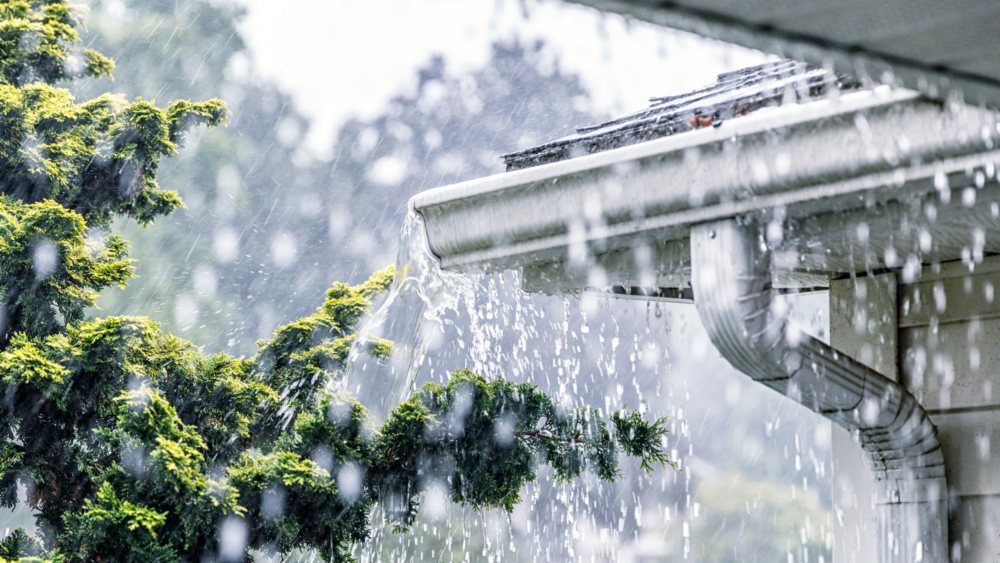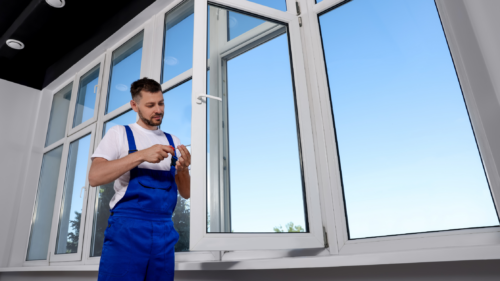Picture this: A serene evening at home, disrupted by the howl of an approaching storm. You’ve seen the news; storms are hitting harder and more often these days. That’s why storm-proofing your home isn’t just wise—it’s essential.
The right moves can keep you safe and save a bundle on repairs. Think reinforced roofs ready to shrug off high winds, windows that laugh in the face of flying debris, and doors firm enough to stand up against nature’s fury. And hey, who wouldn’t love snagging those insurance discounts for being proactive?
You’re about to dive into smart strategies that protect both your wallet and your sanctuary when severe weather strikes.
The Imperative of Storm-Proofing Your Home
Think of your home as a fortress. It needs to stand strong against the onslaught of severe weather, which has been hitting harder and more often than ever before. With most billion-dollar weather events since 1980 coming from these storms, it’s clear that mother nature means business. Global temperatures are on the rise, hinting at even more frequent extreme weather events in our future.
Why Storm-Proofing is a Must in Today’s Climate
Storm-proofing isn’t just about peace of mind; it’s about economic survival. Imagine fierce winds tearing off loose shingles or heavy rain exploiting any weakness to cause water damage. Now picture storm-proofed homes with reinforced roofs ready for high winds and hurricane clips keeping everything firmly attached—these homes stand tall when others falter.
To reduce damage from these violent outbursts of nature, we need to fortify our castles against them. A well-sealed roof house can be your best defense during North Carolina-level hurricanes or Midwest tornadoes alike—a true knight in shining armor for your living space.
The Economic Impact of Extreme Weather on Homes
Buckle up because the numbers don’t lie: Severe storms wreak havoc on bank accounts as much as they do landscapes—just ask anyone who’s had to fix roof leaks after a surprise visit from Mother Nature’s fury. But here’s some good news: investing in storm preparedness measures like surge protectors could not only prevent power surges but also lead to insurance discounts down the road.
In fact, those smart enough to install metal roofing might find their wallets thanking them later—with lifespans reaching half a century and wind resistance up to 140 mph—and let’s not forget how they help prevent glass breakage due to flying debris during storms. And while installing hurricane shutters may seem like an extra step now, think about how grateful you’ll be when they’re all that stands between you and broken windows caused by strong winds.
Data shows us that playing offense is far better than defense when dealing with extreme weather events. It takes time and money upfront but consider this an investment—one where returns come in saved costs after each uninvited tempest passes through town without leaving its mark on your domicile.
Remember: The next big one could be around the corner because climate change waits for no one—and neither should you when it comes making sure every entry point into your haven is sealed tighter than Alcatraz was supposed (but failed) keep inmates inside.
Securing the Structural Integrity of Your Home
Mother Nature can throw a mean punch, but your home doesn’t have to go down without a fight. By making smart structural upgrades, you can stand up to her wildest moods. Think metal roofs laughing in the face of high winds and hurricane straps hugging your house tight when storms get rowdy.
Reinforcing Roofs with Durable Materials
The roof over your head does more than keep out the rain; it’s the frontline defender against severe weather. So what’s this superhero’s cape? Metal roofing is where it’s at – not only does it look sharp for decades, but those sleek panels are also like armor against extreme conditions that would make lesser materials wave a white flag. In fact, these rugged beauties are known to withstand wind speeds up to 140 mph and could last you half a century. Now that’s getting bang for your buck.
To back this up, just watch how metal roofs take on high winds. They’re so good at their job that even North Carolina homes are ditching traditional shingles faster than teens ditch curfew.
Installing Hurricane Straps and Clips for Stability
Surely you’ve seen those wild videos where someone opens a door during heavy rain and air pressure sends everything flying like an indoor tornado? Not cool if it’s happening in real life because your home isn’t properly secured. Enter hurricane straps and clips – they’re essentially big bear hugs for your house from its foundation all the way to its top hat (aka roof). These mighty little steel reinforcements grip onto beams or rafters giving them extra support against strong winds looking to do some serious rearranging.
Homes using building materials fortified with hurricane clips, aren’t just safer; they’re often rewarded with insurance discounts too – talk about smart investing.
In short: Don’t let Mother Nature catch you off guard—arm yourself with knowledge about installing metal roofs and securing them firmly attached with storm-savvy accessories like hurricane straps before she throws her next temper tantrum called ‘extreme weather event’. Because when she comes knocking—or rather pounding—you’ll want every part of your fortress ready check solid as rock.
Window and Door Fortification Techniques
If you’ve ever felt the howl of high winds during a storm, you know your home’s windows and doors are the front line against Mother Nature’s fury. Ensuring these entry points can take a beating is not just smart; it’s critical for keeping everything from flying debris to water damage at bay.
Benefits of Impact-Resistant Glass Against High Winds
Gone are the days when a simple pane of glass would do. Today, impact-resistant glass windows are like silent guardians for your home. They’re designed to withstand serious punches without shattering into dangerous shards that could turn your living room into an indoor wind tunnel or worse, cause injury. With their sturdy construction, they stand up bravely against heavy rain and strong winds—think hurricane-force gales that make trees bend like rubber bands.
The peace of mind isn’t just anecdotal; statistics back it up too. Studies show that these robust warriors can indeed prevent window shatter during tumultuous weather events—a big win if you want to keep everything inside exactly where it belongs.
Protecting Entry Points with Storm Shutters and Reinforced Doors
Moving on from glass fortifications—let’s talk shutters and doors because let’s face it: When those dark clouds roll in, having tough-as-nails barriers between you and what’s brewing outside feels pretty good. Installing storm shutters gives another layer of defense against extreme weather conditions such as hurricanes—and they’re not just functional but also add some aesthetic appeal when skies clear up.
A door isn’t just about saying hello or goodbye—it needs to be built like a fortress gate when storms threaten to knock down your castle walls (figuratively speaking). A reinforced garage door provides extra support crucial for maintaining structural integrity amidst pressure changes caused by high-speed winds barreling around your house corners faster than race cars on tracks.
Hurricane-proof windows paired with proper coverings mean even lightning strikes have less chance causing havoc indoors while surge protectors shield precious electronic devices from unexpected power surges during outages—an all-too-common side effect of severe storms’ wrath.
Your mission? Make sure each window frame firmly attached holds its ground despite what mother nature throws at them because we all know she has quite an arm. Whether DIY project enthusiasts or folks who prefer professional install services getting this job done right means no shortcuts—you wouldn’t skimp on armor going into battle now would ya?
Outdoor Area Safety Measures
When the skies turn grey and heavy rain begins to fall, your outdoor space can quickly become a hazard zone. Without proper prep, patio furniture turns into projectiles, and untrimmed trees could send branches flying. Let’s talk turkey about how you keep your deck in check when Mother Nature throws a tantrum.
Anchoring Patio Furniture Securely
First up is keeping that outdoor furniture from taking flight. It might seem like a heavyweight champ now, but high winds don’t discriminate; they’ll knock out even the sturdiest of lawn chairs. To avoid turning your garden into an obstacle course for squirrels or causing unnecessary damage, anchor down each piece with straps designed for such events—or store them away if Jack Frost really decides to huff and puff.
To make sure those gusts don’t leave you chair-less come morning time, inspect gutters regularly as well—because clogged-up channels mean water backing up and playing Jenga with anything not bolted down during storms.
Tree Trimming Strategies to Reduce Debris Risks
Besides giving nature’s giants a much-needed haircut so they look sharp year-round (you’re welcome), tree trimming goes beyond curb appeal—it’s also about safety. Those leafy limbs hanging over your roof are just waiting for strong winds to use them as battering rams against windows or siding. Strategic pruning makes it less likely that branches will break free and wreak havoc on what lies below.
The trick isn’t just cutting willy-nilly though; you’ve got to think like Edward Scissorhands meets arborist—you want enough off so there’s less risk of flying debris but not too much where trees can’t stay healthy or stable themselves. Remember: Clear does not always equal safe—a balanced approach ensures both beauty and brawn when weather events get feisty.
Electrical System Protection Strategies
When the sky roars with thunder and lightning strikes, your home’s electrical system faces a real heavyweight opponent: power surges. But don’t throw in the towel just yet; surge protectors are like having a top-notch boxer in your corner, ready to take the hit for your precious electronic devices during an unexpected power outage.
Surge Protectors: A First Line of Defense Against Power Surges
A well-placed surge protector can be as crucial as a life jacket on stormy seas. It’s not about if but when those voltage spikes will try to flood your circuits—so make sure you’re prepped ahead of time. Think beyond just plugging into any old power strip; true surge protectors have built-in defenses designed specifically to shield all connected gadgets from sudden jolts of electricity that can occur during heavy weather events.
The aftermath without protection? Let’s just say it involves fried circuit boards and possibly losing those family photos stored on an unprotected PC—all thanks to unchecked high-voltage gatecrashers. So invest wisely because protecting against power surges, especially during extreme weather, is cheaper than replacing every electronic device in your house after Mother Nature decides to flex her muscles.
We’ve all been there—enjoying our favorite TV show when suddenly everything goes dark. Hello, power outage. While we scramble for flashlights and candles, what often gets overlooked is the silent threat posed by these outages once the juice comes back—a spike strong enough to turn our electronics into expensive paperweights. But here’s where surge protectors shine—they act like bouncers at a club door; only letting through energy levels that won’t cause chaos inside.
If you want extra peace of mind knowing that even if lighting does strike twice (or more), grab some additional tools such as uninterruptible power supplies (UPS) or generator backups for long-term blackouts so you won’t miss a beat—or an email—and keep living room movie night going uninterrupted.
To sum up this round-up before stepping out into severe storm territory again: think ahead and give yourself fighting chance against unpredictable elements with solid electrical defense strategies in place—it might just save you from knockout-level repair costs down the line.
Preparing Your Home’s Surroundings
It’s like setting up the ultimate defense for an all-star game – you want every player in top form.
Yard Debris Management
First things first: tackle that yard debris before it turns into flying missiles during high winds. Think of each branch as a potential window smasher or roof piercer. You wouldn’t want loose limbs crashing through windows or denting cars; so clean them up pronto. And while we’re on the subject, make sure to inspect those gutters too because clogged ones will have water doing backflips off your roof faster than an Olympic diver.
Cleaning out dead leaves and twigs is not just about curb appeal—it’s about making sure water has clear pathways to flow away from your home foundation during heavy rain.
Keep Potential Projectiles at Bay
You know how some folks say ‘batten down the hatches’? Well, let’s apply that wisdom here. Secure outdoor furniture by anchoring it firmly to prevent damage – nobody wants their favorite lawn chair taking flight. Also remember those garden decorations and tools—secure them or store them inside before they get swept up in strong winds.
Gutter Inspection
Rain gutters are unsung heroes during weather events—they guide torrents of water like traffic cops at rush hour but only if they’re free from blockages. Keep these channels running smoothly with regular inspections and cleaning; this helps prevent backups which could lead to costly roof leaks or even problems with your home’s foundation due to overflow erosion.
Clear Pathways for Water Flow
Your home’s surroundings act much like nature’s drainage system; however, without proper maintenance, this system can malfunction quicker than a GPS rerouting you into a lake. Make sure that maintain areas around your house isn’t just another item on the honey-do list but rather part of routine checks ensuring ongoing effectiveness against extreme weather conditions.
FAQs in Relation to Storm-Proofing Your Home
How do I Stormproof my house?
To stormproof your home, reinforce the roof, install impact windows and doors, secure outdoor items, and protect against power surges.
How can I protect my house from a storm?
Use hurricane straps for roofs, apply window shutters or films for glass protection, and clear gutters to prevent water damage.
How do I prepare my house for a storm?
Clean up yard debris that could turn into projectiles; check your sump pump is working; stock emergency supplies just in case.
How much does it cost to hurricane-proof your house?
Hurricane proofing costs vary widely based on location and home size but expect thousands—some updates may get insurance discounts though. HomeAdvisor estimates.
Conclusion
Storm-proofing your home is more than just a precaution; it’s an investment in peace of mind. You’ve seen how extreme weather can wreak havoc, but now you know the steps to minimize damage.
From metal roofing that stands up to severe wind, to impact-resistant windows and doors that guard against broken glass—these are essentials for any safe haven. And let’s not forget about securing outdoor areas or beefing up electrical systems with surge protectors—it all adds up to comprehensive protection.
Always remember: Regular maintenance ensures readiness. Check those gutters and trim those trees before nature tests your defenses. When storms loom on the horizon, rest easy knowing you’ve done everything possible to shield your sanctuary.
You’re equipped now—to start storm-proofing wisely, leveraging professional help when needed, aiming for insurance discounts through smart upgrades, and always keeping safety at the forefront. Go ahead—make sure every season is one of security and comfort within your fortified walls.




